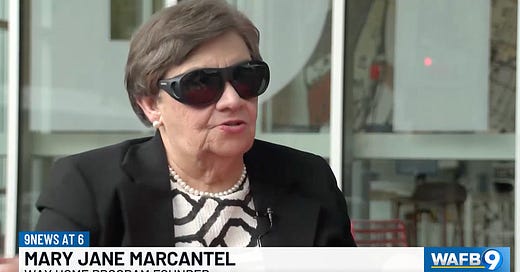Dear Readers,
Apologies for the infrequent posts lately. I’ve been swamped (no pun intended) in another Louisiana three-parter about a missing persons case in Baton Rouge from the late 1980s, a fertile period for us at Gone South. It’s another good versus evil tale. And it’s the first story we’ve told this season that features a repeat guest: Mary Jane Marcantel, the ferocious, sharp-tongued Cajun paralegal, who relishes telling rude and misogynistic cops where they can stick it.
In years of working on and searching for crime stories from the South, I’ve rarely come across such an interesting and unique individual. She seems like the kind of over-the-top character that Nic Pizzolatto of True Detective, who grew up in Mary Jane’s neck of the woods, might invent after repeatedly being told by studio executives that his female characters lack dimension.
Nic: “Oh yeah? Well, how about a 5-foot tall, 70-year-old paralegal-slash-private eye who wears pearls at all times, approaches drug dealers in the middle of the night and talks back to incompetent FBI agents?”
Exec: “Uh, that seems a little far-fetched. Maybe scale it back a bit?”

I met Mary Jane while reporting our other recent three-parter about Scott Rogers, the kooky Baton Rouge TV personality who was unmasked as a sexual predator and cult leader of a UK dance academy. (Listen here if you missed it.) Mary Jane, along with Baton Rouge PR consultant and author Rannah Gray, did most of the legwork that brought Rogers down, resulting in a shocking murder-suicide that left Rogers and one of his former dance students dead. Your average cop or attorney might participate in one such case in their career. For Mary Jane, it seemed like just another day at the office.
During interviews for that series, I spoke with a few people about Mary Jane, asking them, in essence, Is this woman for real? Am I missing something here? I got some funny responses that we weren’t able to include. Here’s one from Don Kelly, the former PIO for the Baton Rouge PD, who suspected Scott Rogers was a fraud from day one.
At one point in my conversations with Mary Jane, I asked if she’d worked on any other cases that we might do for Gone South. Something with a lot of twists and turns?
She laughed. Where to begin? But she did single out one in particular. “If you think the Scott Rogers story is crazy,” she said, “I should tell you about the George Paul ‘Joey’ Smith case some time.”
Actually, this is how she put it to me on the phone.
The gist was that a wealthy guy from the Cottonport area of Louisiana known as Joey Smith had killed his second wife, and allegedly killed his ex-girlfriend, plus a drug dealer or two, before reportedly participating in the disappearance of his third wife. Joey was also cocaine trafficker and prolific insurance fraudster who hailed from a wealthy family of doctors, lawyers and rice farmers. Basically, the Smith family was Central Louisiana’s equivalent of the Murdaugh Family in South Carolina. And Mary Jane, by her own account, had almost single-handedly put Joey — the Smith family’s version of Alec Murdaugh — in prison.
To get a handle on the story, which stretched from the ‘70s to today, I asked if she could sent me a short summary. Maybe a page or two about the main events? Minutes later she emailed me a photocopy of an 87-page timeline, written on a typewriter, on legal-sized paper. It chronicled her obsessive, years-long investigation in microscopic detail. Like this note below on Joey’s meetings with his psychiatrist months before Angie disappeared.
I sighed with a mix of relief and apprehension. Relief that Mary Jane had just dropped another bombshell story on us. Apprehension at the work involved in synthesizing and distilling a deeply complex, 30-year crime saga into a few 30-minute podcast episodes.
But I wound up getting a lot of help from Suzanne Reed, Angie Smiths’ younger sister, who, along with Angie’s mother, worked closely on the case with Mary Jane for years. And of course, Mary Jane was on fire. I struggle to remember what happened last week; Mary Jane recalled detailed conversations from 30 years ago, particularly ones that reveal the laziness and stupidity of certain Louisiana police officers and federal agents.
In addition to drugs, arson, and murder-for-hire, the Joey Smith story also deals with the legacy of slavery in rural Louisiana, a subject we haven’t touched in our many episodes of the show that take place there. The first of three episodes came out last week. Part 2 comes out, as usual, on Wednesday.
Thanks for reading.
Jed




